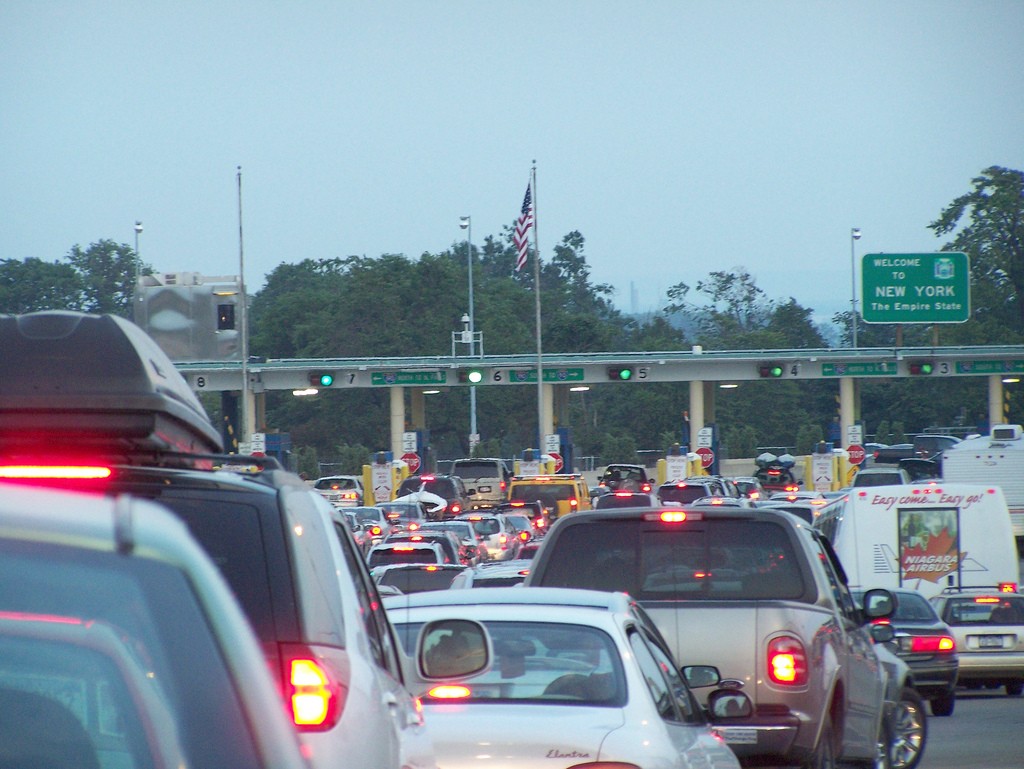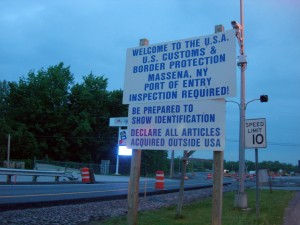We share a border, and public radio too!

Long waits are the order of the day at busy crossings such as the one at Champlain, NY and this one, the Peace Bridge border crossing at Buffalo, NY. Photo: chapstickaddict, Creative Commons, some rights reserved
About three weeks ago, Prime Minister Justin Trudeau went to Washington and had a great visit with President Barack Obama. Not since the friendly golf games of the 1990s between Bill Clinton and Jean Chretien or the 1985 performance of When Irish Eyes Are Smiling by the Reagan and Mulroney couples on a Quebec City stage has the relationship between a Canadian Prime Minister and an American President been so good. One of the things the two next-door neighbor leaders agreed upon during their visit was to make it easier for the rest of us to cross the Canada-U.S. border.
The Canada Border Services Agency (CBSA) and the U.S. Border Patrol are soon going to start swapping information about who is crossing over the line. Surprisingly, they aren’t already doing this. The new plan means that Uncle Sam will soon be able to get information from Johnny Canuck about whoever is stopping at the customs booth. Her Majesty’s Canadian government will be able to do the same with information from the adjoining republic.
Sharing information on border crossers is naturally raising privacy concerns, which are completely valid after concerns about the activities of electronic spy agencies in both the United States and Canada in recent years. The plan is designed to make traffic move more quickly, particularly at land crossings. In our region, that means the busy Thousand Islands Bridge, the Cornwall-Massena crossing, and where Interstate 87 meets Quebec Highway 15 near Champlain. Swapping details on who is crossing is supposed to reduce the long waits that are common at locations like those. The border guard in the booth will already know things about you before you even have the car in park.

Smaller ports of entry, such as the Cornwall, ON – Massena, NY crossing rarely back up. Photo: Jimmy Emerson, Creative Commons, some rights reserved
The plan could very well reduce waiting times (I waited for over two hours at Champlain one day last summer), but does it really matter for the many smaller, less-busy border crossings in our region? The Prescott-Ogdensburg Bridge was built with high hopes in 1960, just after the St. Lawrence Seaway opened. It was built to accommodate much more traffic than it usually sees. Although connected to Highways 401, 416, and reasonably close to Ottawa and Montreal, it has no connection to a freeway or major city in New York. The result is much lower traffic volumes on the Prescott-Ogdensburg Bridge, even though the facilities there are made to handle much higher levels. A 20-minute wait in either direction is considered long at that bridge, and only one customs both is usually open on either side.
The border goes inland at Akwesasne. It follows the 45th parallel right through to the wilderness of northern New Hampshire and southeastern Quebec. Most of the border crossings along there are very lightly used. The border runs right through small towns, barnyards, and even houses. Road crossings are usually lightly traveled rural roads and village streets. Will an international agreement to share information on whoever is crossing really matter at places where the traffic and wait times are so light already? Probably not. In many of these villages and rural areas, the border doesn’t mean a whole lot anyway.
Of course honest, law-abiding citizens respect it, but there are family, friends, and neighbors on each side. Border guards quite likely fall into all of these categories too. Someone crossing the border in Trout River where New York Route 30 meets Quebec Route 138 is quite possibly on their way to visit relatives, friends, or even work. In a small town, everyone knows things about each other anyway, even if there isn’t an international boundary running down the main street.
The border is not something that divides the North Country from eastern Ontario and southern Quebec. It’s as much a part of the social and cultural fabric of the region as it is a political and legal part. North Country Public Radio is a big part of our local cultural life too. It brings friends and neighbors on both sides of the border together. It says a lot about commitment to community when the staff and management in Canton pay attention to what’s happening in Brockville, Ottawa, Cornwall, and Huntingdon. The music and stories get the attention of Canadian listeners because of their uniqueness and the willingness of the programmers to highlight people and things that other media outlets often ignore. We have something special here. While presidents and prime ministers talk about how to make crossing the border we share faster, a contribution to NCPR’s spring fundraising campaign helps keep something we also share going strong.
Tags: border, canada, NCPR fundraising, north country, Ontario, Quebec, security, USA







